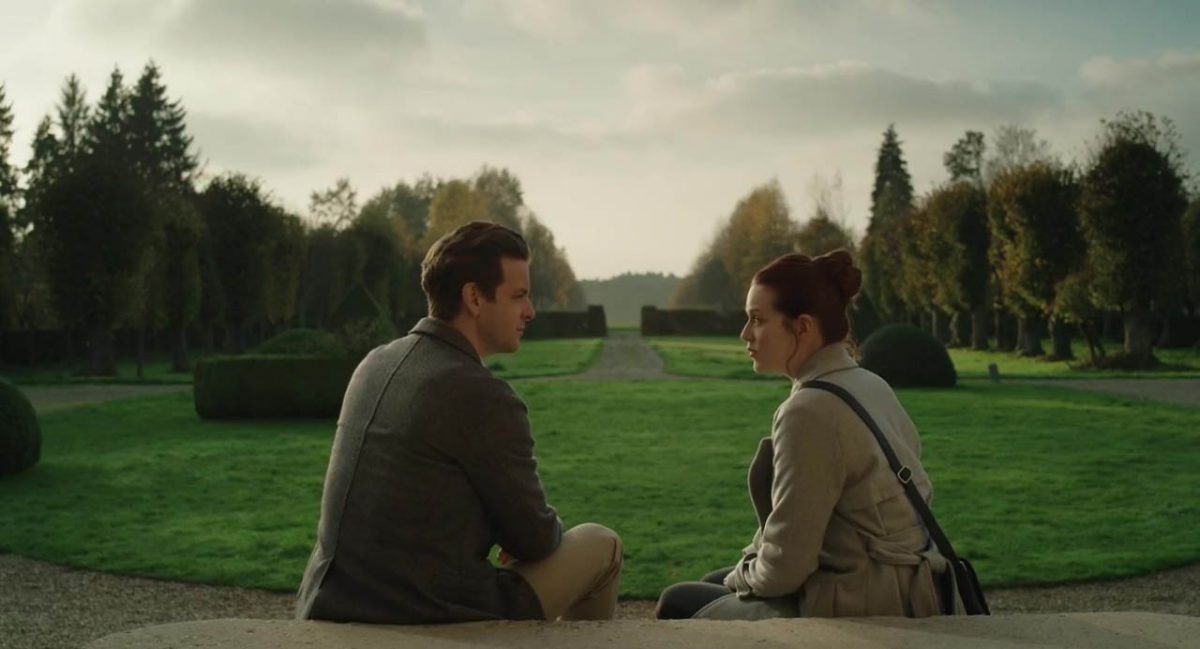The social and cultural implications of the present pandemic are so incisive, it feels impossible not to see it in any media that we consume. So, even though Oliver Krimpas’s “Around the Sun” was shot years ago, and premiered across a few festivals in 2019, the film’s release to streaming services last week felt particularly apt. Krimpas’s film, which features just two characters, is part philosophy discourse, part romance, part science-fiction and a beguiling whole of something unusual . The plot, in the loosest of terms, sees estate-agent Maggie guiding Bernard, a location-scout, around a large – and very empty –aristocratic manor and its lawns over the course of a day. As the two traverse the grounds and the buildings, their isolation feels so stark and like a manifestation of social distancing. Over the course of the film, Maggie and Bernard walk and talk in isolation and beyond a brief plot-point involving a text-message, the two seem cut off from the world outside even as they are – keyed into larger themes of the universe. It is apt for the current times.
It is ironic that the film is betrayed by its title, which sounds too generic for a film that is so very, very specific. Specificity is central to the film, as is location. Bernard is scouting a location for a film that may not even have been written, but the estate he arrives at is hardly accidental. Five centuries ago, Bernard le Bovier Fontenelle conceived his revolutionary “Conversations on the Plurality of the Worlds” at that same chateau. His book was constructed as a series of conversations between the ever-questioning Fontenelle and a young Marquise performing a series of philosophical-scientific conversations on the nature of being and the model of the universe.
Fontenelle’s book would become one of the earliest works of popular science on heliocentrism. It seems an unlikely subject for a quasi-romance. But the unusual meeting of subject and form feels current.
“Around the Sun” is nothing, if not niche. In its nicheness, the film is especially self-conscious in its metatheatricality. It’s a self-consciousness that rarely feels like a flaw and more like a charming indicator of Krimpas (he writes and directs the film) and his fascination with the elusive and illusory. The film develops as an examination and as a re-presentation of Fontenelle’s discourse. Except, it is Maggie who takes the reins and intimates to Bernard the value of Fontenelle’s work, using it is as a springboard to talk about the usual exigencies of life – love, family, romance, dreams and desires.
If this all sounds quite mundane in the way of conflict, you would not be incorrect. The closest thing to a crisis is the potential maybe-maybe not newly pregnant wife that Bernard may-or-may-not have somewhere. In true self-reflexive fashion, the way the film deploys and then solves that particular arc is charming for its own winking knowingness than anything. True to specificity, the particular value of Fontenelle for this particular meeting is revealed in a way that feels incredibly worked out but unforced, emphasising the way the film manages to feel both spontaneous but intentional in a charming sleight-of-hand. And charm is what carries the film. Cara Theobold and Gethin Anthony have a sedate chemistry that feels tender if not necessarily kinetic. This makes sense for a film that flirts with romance but declines anything declarative. The romance is suggested and never manifested – best elicited in the lingering glances.
The weakest sequence of the film disrupts that sedateness. Things go slightly off-course when a bottle of alcohol appears to precipitate a drunken scene that will excavate depths of Bernard and Maggie’s past. Drunk acting can always be hit-or-miss and especially here it seems at odds with the hitherto softness of the dynamic at work. But, as “Around the Sun” goes on there’s a compelling challenge that it presents to its audience as we’re invited to consider even its moments of weakness as part of the film’s own interrogation. In classic philosophising stance, the film seems to be asking us to comment on its own issues.
Towards the end the film explicitly offers up a defence and challenge to us that feels too fascinating to ignore, even if it feels too easy to explain away any criticism: “And if there really are infinite stars, does that not mean that any constellation that we could possibly imagine, any little connect-the-dots you could make, must exist somewhere? Like, all you need is the proper vantage point to see it from, and the propensity to look for it.”
It’s an explanation that’s too easy in some ways. If context is all you need, then anything – no matter how great and terrible – could be excused as existing, or not existing. But it returns to the question of charm in the way that Krimpas’s film is so generously ambivalent about its own diegesis or rules of worlds.
There’s a swift montage at the climax that invites us to recontextualise what we’ve seen as the film manifests Fontenelle’s considerations of the multi-universe in an amusing sequence. The sequence, simultaneously daring and sedate, is the best representation of “Around the Sun” which is so simple and straightforward and yet seems to flirt with something that is almost too arcane and weird to be the subject of a film. Throughout, the entire thing is so tenderly amiable that it’s incredibly slight 80-minute running time feels like a tiny gift. In a recurring visual cue, the camera pans out, rendering Maggie and Bernard as tiny images in the vastness of the manor – and the world. Krimpas’ unsubtle point about our own inconsequentiality in the face of the world is important. But, “Around the Sun” is so warm, we might not even realise we’re being lectured.
Around the Sun is available for purchase and rental on Vudu and Amazon Prime Video.






